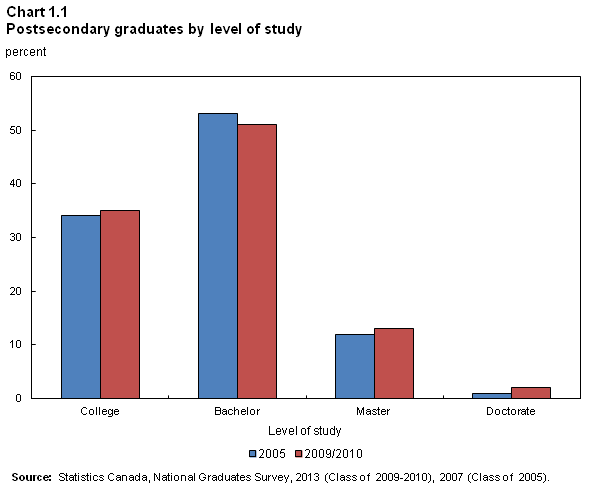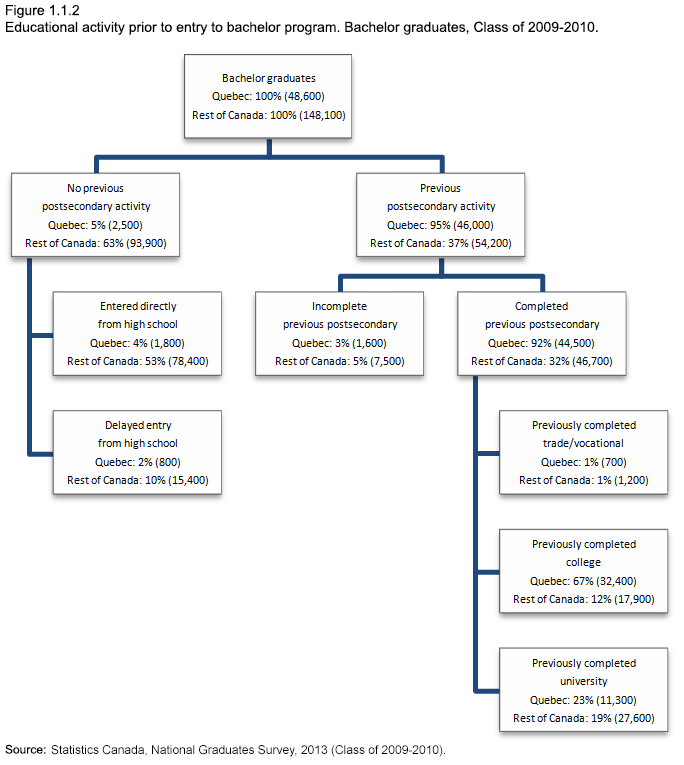Publications
Culture, Tourism and the Centre for Education Statistics: Research Papers
Graduating in Canada: Profile, Labour Market Outcomes and Student Debt of the Class of 2009-2010 - Revised
Section 1
Profile and educational pathways of graduates
Archived Content
Information identified as archived is provided for reference, research or recordkeeping purposes. It is not subject to the Government of Canada Web Standards and has not been altered or updated since it was archived. Please "contact us" to request a format other than those available.
The Class of 2009-2010 was the first National Graduates Survey cohort after the 2008 economic downturn, which was a time of demographic shifts, economic uncertainty and changes in the labour market emphasizing the need for a highly educated workforce. In 2009-2010, almost 389,000 students graduated from Canada’s public colleges and universities. Of all graduates, those at the bachelor level represented the largest proportion (51%), however, they comprised a lower proportion compared with 2005 (53%). On the other hand, as shown in Chart 1.1, college, master and doctorate graduates represented larger shares of overall graduates in 2009-2010 compared with 2005.

The majority of graduates were women, representing 56% of college graduates and 61% of bachelor graduates (Appendix table A.1).
Notes on the Classification of Instructional Programs (CIP, Canada 2000)
The NGS codes fields of study according to the Classification of Instructional Programs (CIP, Canada 2000). The CIP 2000 contains over 1600 detailed fields of study designed to reflect the varied fields offered by Canadian educational institutions.
CIP has 13 groupings, called Primary groupings, at the most aggregated level. These are referred to in this report as ‘major’ or ‘primary’ groupings. At a more detailed level, CIP has groupings called 2-digit groupings. These are referred to in this report as ‘minor’ groupings. The groupings are delineated by the use of quotation marks.
For more information on the CIP, Canada 2000 please see: http://www.statcan.gc.ca/concepts/classification-eng.htm
In male dominated fields of study, the proportion of female graduates was higher at the master level than the bachelor level
Similar to 2005, women represented the majority of college and university graduates in most fields of study with the female share being highest in ‘education’ and ‘health’. Men represented a higher proportion of those who graduated from ‘personal, protective and transportation services’, ‘architecture and engineering and related services’ and ‘mathematics and computer sciences’ (Appendix table A.2). Similar to 2005, these were the only primary grouping fields of study where men were the majority of graduates at the bachelor and master level.
While women were still in the minority in these fields there was a higher proportion of female graduates at the master level compared to the bachelor (Chart 1.2) suggesting that a higher proportion of females went on to pursue a master degree in male dominated fields of study. For example, the female share of master graduates in ‘architecture and engineering and related technologies’ was 29% compared to 19% at the bachelor level. Similarly, among master graduates in ‘mathematics, computer and information sciences’, the female share was 43% compared with 19% among bachelor graduates.

College graduates tended to be older in 2009-2010 compared with college graduates in 2005
Figure 1.1.1 illustrates the educational pathways of college graduates prior to the postsecondary program they completed in 2009-2010. Just over half (53%) of college graduates entered their program from a high school program either directly (28%) or after a delayed period of 12 months or more (24%) and had no previous postsecondary activity. This represented a slight increase in those delaying entry to a college program from high school compared with 22% in 2005. The average age of college graduates was also two years older (28 years old) compared with those graduating in 2005 (26 years old). This may be related to the increase in delaying entry from high school and also that a somewhat higher proportion of 2009-2010 college graduates (47%) had previous postsecondary participation compared with 2005 (45%).
Figure 1.1.2 illustrate the educational pathways of bachelor graduates prior to the postsecondary program they completed in 2009-2010. Results at the bachelor level are provided separately for Quebec graduates and graduates from the rest of Canada (outside Quebec) due to the unique education system in Quebec which requires that students complete a two-year college program at a CEGEP (Collège d’enseignement général et professionnel) as a prerequisite for university. The following analysis focuses on the proportion of bachelor graduates outside of Quebec only.
While a higher proportion of college graduates had previously pursued a postsecondary program compared with bachelor graduates, a similar proportion had completed their studies
The proportion of graduates who had completed a previous postsecondary program was similar between college graduates (34%) and bachelor graduates outside of Quebec (32%) as shown in Figures 1.1.1 and 1.1.2. However, it was more common for college graduates to have pursued but not completed a previous program (13%) compared with bachelor graduates (5%). This resulted in the proportion of those who previously pursued postsecondary education to be higher among graduates with a college diploma (47%) compared with those with a bachelor degree (37%). (Figures 1.1.1 and 1.1.2)
Among those who had completed their credential, college graduates were almost equally as likely to have previously completed a university degree as a college diploma (15% and 16% respectively). However, bachelor graduates were more likely to have previously completed a university degree (19%) than a college diploma (12%).
In Quebec, with the CEGEP system, most bachelorNote 4 graduates had previously participated in postsecondary education (95%) and about 9 of 10 (92%) had previously completed their credential. Two-thirds (67%) of those who completed a bachelor degree in 2009-2010 had previously completed a college/CEGEP program and almost one quarter (23%) had previously completed a university degree. (Figure 1.1.2)


Summary
College, master and doctorate graduates represented larger shares of overall graduates in 2009-2010 compared with 2005, while the proportion of bachelor graduates was smaller.
Similar to 2005, women continued to represent the majority of college and university graduates in all fields except for ‘personal, protective and transportation services’, ‘architecture and engineering’ and ‘mathematics and computer sciences’. Of graduates in these three major fields of study, a higher proportion of females graduated at the master level than the bachelor level suggesting that a higher proportion of women went on to pursue a masters degree in male dominated fields of study.
College graduates tended to be older in 2009-2010 compared to 2005. In part this may be attributable to the increased proportion of college graduates who delayed entry from high school and an increase in the proportion with previous postsecondary education.
While a higher proportion of college graduates had previously pursued a postsecondary program compared with bachelor graduates, a similar proportion had completed their studies. The proportion of those who had completed a previous postsecondary program was similar between college graduates and bachelor graduates outside of Quebec (34% versus 32% respectively). However, it was more common for them to have pursued but not completed their previous program (13%) compared with bachelor graduates (5%). This resulted in the proportion of college graduates who previously pursued postsecondary education to be higher among those with a college diploma (47%) compared with those with a bachelor degree (37% outside of Quebec).
Notes
- Date modified:
